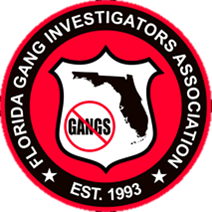| Florida Gang Investigators AssociationIntegrity , Leadership, Pride & Professionalism |
Florida Gang Statute - 874
Florida Statute §874 referred to as the “Criminal Gang Prevention Act" sets forth the rules at it relates to gang member identification, gang related incidents and so forth.
874.03 Definitions.—As used in this chapter:
(1) “Criminal gang” means a formal or informal ongoing organization, association, or group that has as one of its primary activities the commission of criminal or delinquent acts, and that consists of three or more persons who have a common name or common identifying signs, colors, or symbols, including, but not limited to, terrorist organizations and hate groups.
(a) As used in this subsection, “ongoing” means that the organization was in existence during the time period charged in a petition, information, indictment, or action for civil injunctive relief.
(b) As used in this subsection, “primary activities” means that a criminal gang spends a substantial amount of time engaged in such activity, although such activity need not be the only, or even the most important, activity in which the criminal gang engages.
(2) “Criminal gang associate” means a person who:
(a) Admits to criminal gang association; or
(b) Meets any single defining criterion for criminal gang membership described in subsection (3).
(3) “Criminal gang member” is a person who meets two or more of the following criteria:
(a) Admits to criminal gang membership.
(b) Is identified as a criminal gang member by a parent or guardian.
(c) Is identified as a criminal gang member by a documented reliable informant.
(d) Adopts the style of dress of a criminal gang.
(e) Adopts the use of a hand sign identified as used by a criminal gang.
(f) Has a tattoo identified as used by a criminal gang.
(g) Associates with one or more known criminal gang members.
(h) Is identified as a criminal gang member by an informant of previously untested reliability and such identification is corroborated by independent information.
(i) Is identified as a criminal gang member by physical evidence.
(j) Has been observed in the company of one or more known criminal gang members four or more times. Observation in a custodial setting requires a willful association. It is the intent of the Legislature to allow this criterion to be used to identify gang members who recruit and organize in jails, prisons, and other detention settings.
(k) Has authored any communication indicating responsibility for the commission of any crime by the criminal gang.
Where a single act or factual transaction satisfies the requirements of more than one of the criteria in this subsection, each of those criteria has thereby been satisfied for the purposes of the statute.
(4) “Criminal gang-related activity” means:
(a) An activity committed with the intent to benefit, promote, or further the interests of a criminal gang, or for the purposes of increasing a person’s own standing or position within a criminal gang;
(b) An activity in which the participants are identified as criminal gang members or criminal gang associates acting individually or collectively to further any criminal purpose of a criminal gang;
(c) An activity that is identified as criminal gang activity by a documented reliable informant; or
(d) An activity that is identified as criminal gang activity by an informant of previously untested reliability and such identification is corroborated by independent information.
(5) “Electronic communication” has the meaning provided in s. 934.02 and includes, but is not limited to, photographs, video, telephone communications, text messages, facsimile, electronic mail messages as defined in s. 668.602, and instant message real-time communications with other individuals through the Internet or other means.
(6) “Hate group” means an organization whose primary purpose is to promote animosity, hostility, and malice against a person or persons or against the property of a person or persons because of race, religion, disability, sexual orientation, ethnicity, or national origin.
(7) “Terrorist organization” means any organized group engaged in or organized for the purpose of engaging in terrorism as defined in s. 775.30. This definition shall not be construed to prevent prosecution under this chapter of individuals acting alone.

